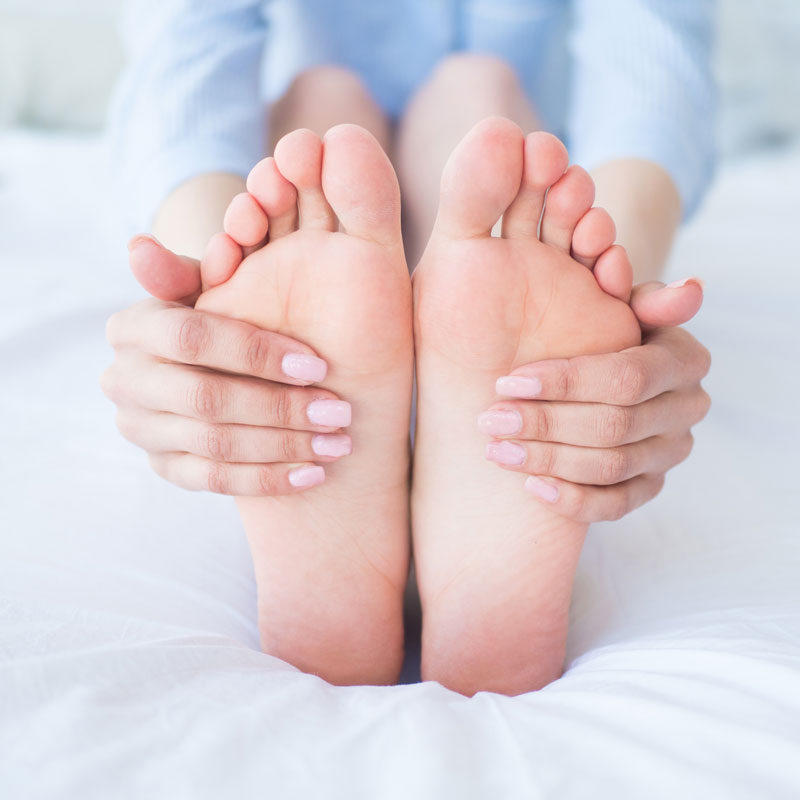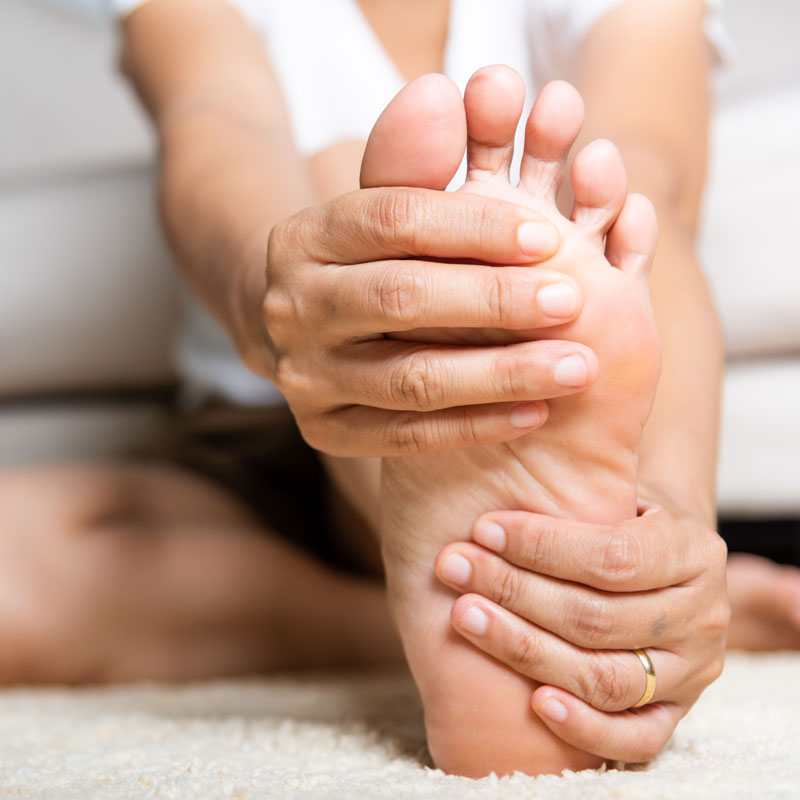Diabetes
Understanding Diabetes and Foot Health Risks in Sugar Land, TX
Diabetes mellitus is a chronic disease that affects the lives of about 16 million people in the United States, 5.4 million of whom are unaware that they even have the disease. Every day, 2,200 new cases of diabetes are diagnosed, and an estimated 780,000 new cases are identified each year. The disease is marked by the inability to manufacture or properly use insulin and impairs the body’s ability to convert sugars, starches, and other foods into energy. The long-term effects of elevated blood sugar (hyperglycemia) are damage to the eyes, heart, feet, kidneys, nerves, and blood vessels.
Symptoms of hyperglycemia may include frequent urination, excessive thirst, extreme hunger, unexplained weight loss, tingling or numbness of the feet or hands, blurred vision, fatigue, slow-to- heal wounds, and susceptibility to certain infections. People who have any of these symptoms and have not been tested for diabetes are putting themselves at considerable risk and should see a physician without delay.
Part of keeping your diabetes in control is testing your blood sugar often. Ask your doctor how often you should test and what your blood sugar levels should be. Testing your blood and then treating high blood sugar early will help you to prevent complications.
The socioeconomic costs of diabetes are enormous. The costs have been estimated at $98 billion annually, about $44 billion of which are direct costs from the disease with $54 billion indirectly related. Diabetes is the sixth leading cause of death by disease in the United States, and individuals with diabetes are two to four times as likely to experience heart disease and stroke.
The growth of the disease worldwide is especially alarming. The World Health Organization (WHO) expects the number of new diabetes cases to double in the next 25 years from 135 million to nearly 300 million. Much of this growth will occur in developing countries where aging, unhealthy diets, obesity, and sedentary lifestyles will contribute to the onset of the disease.
According to a recent survey, about 86,000 lower limbs are amputated annually due to complications from diabetes.
The primary goal of most early treatment options is to relieve pressure on the bunion and halt the progression of the joint deformity. A podiatric physician may recommend these treatments:
Diabetes is the leading cause of end-stage kidney disease, accounting for about 40 percent of new cases.
Diabetes is the leading cause of new cases of blindness among adults, age 20 to 74. While there is no cure for diabetes, there is hope. With a proper diet, exercise, medical care, and careful management at home, a person with diabetes can keep the most serious of the consequences at bay and enjoy a long, full life.

How Do You Get Diabetes?
No one knows why people develop diabetes, but once diagnosed, the disease is present for life. It is a hereditary disorder, and certain genetic indicators are known to increase the risk of developing diabetes. Type 1, previously known as insulin-dependent diabetes mellitus or juvenile-onset diabetes, afflicts five to ten percent of diagnosed cases of diabetes. This type occurs most frequently in children and adolescents, and is caused by the inability of the pancreas to produce the insulin needed for survival. Type 2, previously called noninsulin-dependent diabetes mellitus or adult-onset diabetes, affects the other 90-95 percent of all diagnosed cases of diabetes, many of whom use oral medication or injectable insulin to control the disease. The vast majority of those people (80 percent or more) are overweight; many of them obese, as obesity itself can cause insulin resistance.
What Are the Causes of Diabetes
Certain characteristics put people at a higher risk of developing Type 2 diabetes. These include:
- A family history of the disease
- Obesity
- Prior history of developing diabetes while pregnant
- Being over the age of 40
- Being a member of one of the following ethnic groups:
- African American
- Native American
- Latino American
- Asian American
- Pacific Islander
- African Americans are 1.7 times more likely to have diabetes than the general population, with 25 percent of African Americans between the ages of 65 and 74 diagnosed with the disease.
- Hispanic Americans are almost twice as likely to develop type 2 diabetes, which affects 10.6 percent of that population group.
- Native Americans are at a significantly increased risk for developing diabetes, and 12.2 percent of the population suffers from the disease. In some tribes, as many as 50 percent of its members have diabetes.
- Of all the risk factors, weight is the most important, with more than 80 percent of diabetes sufferers classified as overweight.

The Role of Your Podiatric Physician
Because diabetes is a systemic disease affecting many different parts of the body, ideal case management requires a team approach. The podiatric physician, as an integral part of the treatment team, has documented success in the prevention of amputations. The key to amputation prevention in diabetic patients is early recognition and regular foot screenings, at least annually, from a podiatric physician.
In addition to these checkups, there are warning signs that you should be aware of so that they may be identified and called to the attention of the family physician or podiatrist. They include:
- Skin color changes
- Elevation in skin temperature
- Swelling of the foot or ankle
- Pain in the legs
- Open sores on the feet that are slow to heal
- Ingrown and fungal toenails
- Bleeding corns and calluses
- Dry cracks in the skin, especially around the heel

Wound Healing
Ulceration is a common occurrence with the diabetic foot and should be carefully treated and monitored by a podiatrist to avoid amputations. Poorly fitted shoes, or something as trivial as a stocking seam, can create a wound that may not be felt by someone whose skin sensation is diminished. Left unattended, such ulcers can quickly become infected and lead to more serious consequences. Your podiatric physician knows how to treat and prevent these wounds and can be an important factor in keeping your feet healthy and strong. New to the science of wound healing are remarkable products that have the appearance and handling characteristics of human skin. These living, skin-like products are applied to wounds that are properly prepared by the podiatric physician. Clinical trials have shown impressive success rates.
If You Have Diabetes Already
- Wash feet daily – Using mild soap and lukewarm water, wash your feet in the mornings or before bed each evening. Dry carefully with a soft towel, especially between the toes, and dust your feet with talcum powder to wick away moisture. If the skin is dry, use a good moisturizing cream daily but avoid getting it between the toes.
- Inspect feet and toes daily – Check your feet every day for cuts, bruises, sores, or changes to the toenails, such as thickening or discoloration. If age or other factors hamper self-inspection, ask someone to help you, or use a mirror.
- Lose weight – People with diabetes are commonly overweight, which nearly doubles the risk of complications.
- Wear thick, soft socks – Socks made of an acrylic blend are well suited but avoid mended socks or those with seams, which could rub to cause blisters or other skin injuries.
- Stop smoking – Tobacco can contribute to circulatory problems, which can be especially troublesome in patients with diabetes.
- Cut toenails straight across – Never cut into the corners, or taper, which could trigger an ingrown toenail. Use an emery board to gently file away sharp corners or snags. If your nails are hard to trim, ask your podiatric physician for assistance.
- Exercise – As a means to keep weight down and improve circulation, walking is one of the best all-around exercises for diabetic patients. Walking is also an excellent conditioner for your feet. Be sure to wear appropriate athletic shoes when exercising. Ask your podiatric physician what’s best for you.
- See your podiatric physician – Regular checkups by your podiatric physician-at least annually-are the best way to ensure that your feet remain healthy.
- Be properly measured and fitted every time you buy new shoes – Shoes are of supreme importance to diabetes sufferers because poorly fitted shoes are involved in as many as half of the problems that lead to amputations. Because foot size and shape may change over time, everyone should have their feet measured by an experienced shoe fitter whenever they buy a new pair of shoes.
New shoes should be comfortable at the time they’re purchased and should not require a “break-in” period, though it’s a good idea to wear them for short periods of time at first. Shoes should have leather or canvas uppers, fit both the length and width of the foot, leave room for toes to wiggle freely, and be cushioned and sturdy.
- Don’t go barefoot – Not even in your own home. Barefoot walking outside is particularly dangerous because of the possibility of cuts, falls, and infection. When at home, wear slippers. Never go barefoot.
- Don’t wear high heels, sandals, and shoes with pointed toes – These types of footwear can put undue pressure on parts of the foot and contribute to bone and joint disorders, as well as diabetic ulcers. In addition, open-toed shoes and sandals with straps between the first two toes should also be avoided.
- Don’t drink in excess – Alcohol can contribute to neuropathy (nerve damage) which is one of the consequences of diabetes. Drinking can speed up the damage associated with the disease, deaden more nerves, and increase the possibility of overlooking a seemingly minor cut or injury.
- Don’t wear anything that is too tight around the legs – Pantyhose, panty girdles, thigh-highs, or knee-highs can constrict circulation to your legs and feet, as can men’s dress socks if the elastic is too tight.
- Never try to remove calluses, corns, or warts by yourself – Commercial, over-the-counter preparations that remove warts or corns should be avoided because they can burn the skin and cause irreplaceable damage to the foot of a diabetic sufferer. Never try to cut calluses with a razor blade or any other instrument because the risk of cutting yourself is too high, and such wounds can often lead to more serious ulcers and lacerations. See your podiatric physician for assistance in these cases.